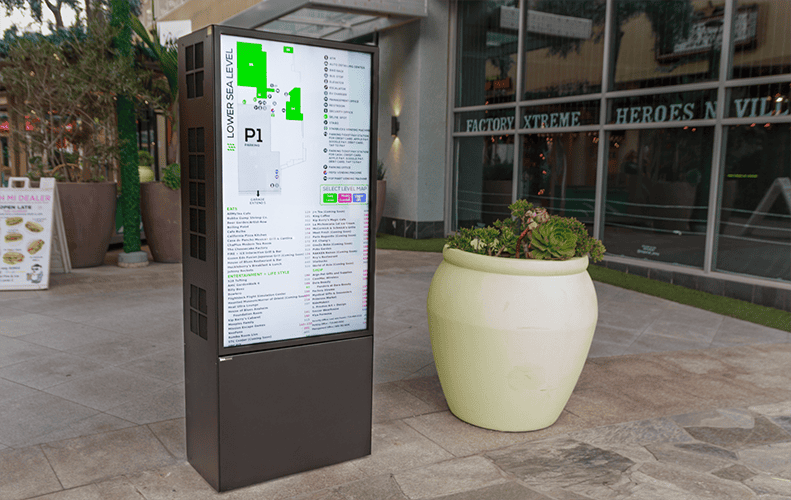From helping customers locate stores in the mall to providing educational information in front of museum exhibits, digital kiosks are everywhere. They are one of the defining technological innovations brands have leveraged to deepen customer engagement. If your business has yet to incorporate display kiosks, you may wonder — what is a digital kiosk, and how might it benefit my business? Learn more about the advantages and applications of digital kiosks.
What Are Digital Kiosks? How Do They Differ From Similar Technologies?
A digital kiosk is a free-standing interactive screen that offers customers or passersby various functions. The goal is to provide customers with information or services without needing additional staff. Businesses also use them to brand and promote products, services, discounts, and more. Benefits of using digital kiosks for businesses include:
- An improved customer experience
- Increased operational efficiency
- Cost-savings (on labor and resources)
- Opportunities to upsell
- Real-time data analytics for providing personalized experiences
Key Components of a Digital Kiosk
Digital kiosks have various features that power their advanced capabilities. Different kiosks will have unique features depending on the company’s goals, but all contribute to an enhanced customer experience. The main components include:
- Display screen: The display screen provides customers with a combination of branded written and visual content that answers their questions or helps them discover something new.
- Touchscreen interface: Like a smartphone or tablet, interactive kiosks have touchscreen interfaces for user-friendly navigation.
- Connectivity options: Internet connectivity ensures more up-to-date information and enables customers to make online purchases directly from the kiosk.
- Software and content management: Software ensures kiosks continue operating effectively. They provide businesses with the tools they need to create content, manage the kiosk, and deliver custom experiences.
Types of Digital Kiosks
There are various ways to distinguish display kiosks. The most basic is outdoor vs. indoor, with outdoor kiosks typically designed to withstand more wear and tear. Other differentiations include configuration, such as free-standing, wall-mounted, and tablet kiosks. Some are better suited for specific industries, and businesses must consider their needs to determine which display kiosks are best.
Another distinction is function. The following discusses four common types of digital kiosks based on capability:
Informational Kiosks
As the name suggests, the main purpose of digital information kiosks is to provide information about products, services, promotions, and events. Many digital kiosks are primarily informational but may incorporate other functions like wayfinding, barcode/QR scanning, check-in, and secure transactions.
Transactional Kiosks
Transactional kiosks are primarily used for buying products and services. As such, they support payment capabilities like credit and debit card transactions and NFC contactless payments. Transactional kiosks may also have vending and dispensing functions. For example, kiosks outside movie theaters allow customers to purchase and print out tickets.

Wayfinding Kiosks
Wayfinding kiosks help customers navigate businesses. They are especially helpful in large venues, like shopping malls, parks, and zoos. With wayfinding kiosks at strategic locations on-site, customers can view digital maps to locate stores, restrooms, restaurants, and more.
Wayfinding kiosks may use traditional, 2D maps or 3D models. Ultimately, they enhance the experience by eliminating the time customers spend looking for the services they need.
Interactive Digital Signage
Digital signage, also called advertising display kiosks, is primarily used for sharing marketing materials with customers. Unlike traditional ads, they allow for more engagement. Customers can click on ads to learn more about specific offerings and discover where these products or services are located on-site.
Companies often opt for digital signage over traditional, static signage because it’s easier to change. This way, businesses can ensure the discounts and deals highlighted are current.
Applications of Digital Kiosks
Market researchers expect the interactive digital kiosk market to grow in the coming years. According to PR Newswire, the global interactive kiosk market is expected to reach a $42.8 billion value by 2030, growing at a CAGR of 6.33%. The versatility of digital kiosks in part explains their widespread adoption. Consider how the following industries use display kiosks and digital signage:
Retail
For retail stores, digital kiosks enable self-checkout and provide product information. Customers can also learn about sales happening now. One of the most innovative applications is virtual try-on in department stores, where customers can try on clothes without changing.
Healthcare
In healthcare organizations, digital kiosks boost efficiency and promote a better patient experience. They assist with check-in and wayfinding. They can also provide key health information, such as about vaccinations. In some facilities, digital kiosks can be configured for telehealth appointments.
Transportation
Airports, bus terminals, train stations, and other transportation centers use digital kiosks for self-check-in, ticket vending, and providing information about routes and departure times. This streamlines day-to-day efforts for a better passenger experience.
Interactive Kiosks From DSA Signage
Incorporate display kiosks into your business strategy to enhance efficiency and customer experience and save costs. At DSA Signage, we offer a range of digital signage options, including interactive kiosks, in different sizes and configurations. Contact us today to request a quote for digital signage and other products.
 DSA Signage
DSA Signage